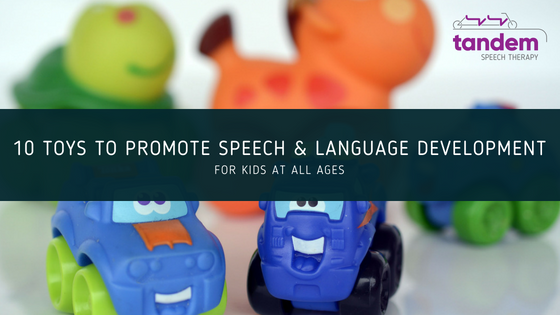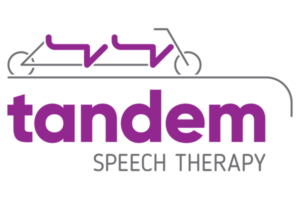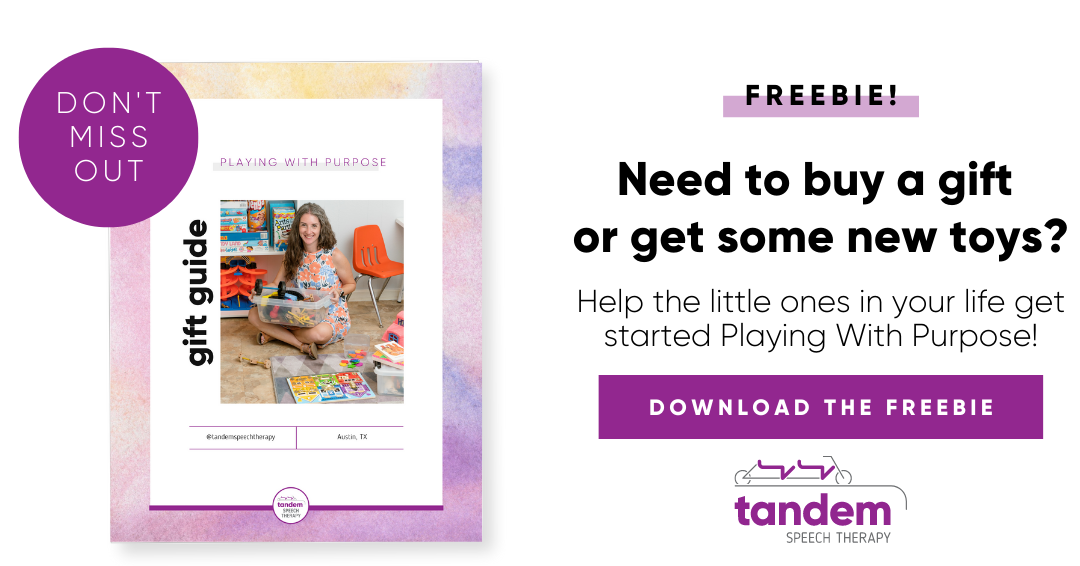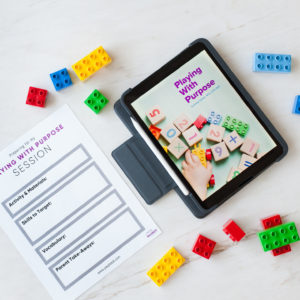Images in this blog post contain Amazon affiliate links.

Children spend most of their time in play which helps them understand their environment and interact with people. Nothing beats toys that children can hold and share with others. As a pediatric speech-language pathologist, I am frequently asked for toy recommendations. Whether it’s from my friends or my client’s parents, I often share the same tips and ideas. Before you head to the store or hop on your favorite online retailer’s website, let’s quickly review my tips for choosing toys. You can also read about it in a previous blog post for more details.
My all-time #1 tip and piece of advice, when buying toys for kids, is to DITCH THE BATTERIES. When playing, we want our kids to do the work, not the toy! This provides the canvas for speech-language stimulation–for opportunities to increase a child’s speech and language use along with igniting the spark to build interaction and knowledge. One way to go about getting rid of toys with batteries is to go back to the basics. This is another tip you’ll find in that other blog post. Think about the toys you played with. Many of them are what we refer to as open-ended toys. These are toys that can be played with in a variety of ways and do not have a beginning or end.
Nearly all the toys in my speech therapy office are open-ended toys. You’ll find items like a farm set, books, and magnetic blocks along with all kinds of toys that your 2-year-old would be interested in such as cars and a ball. Nothing fancy because when it comes to promoting speech and language development, YOU (the caregiver) are the best toy. You are the one who will provide the language and stimulation your child needs to start talking, if they are not already, or use more words and understand basic concepts.
10 Toys That Can Promote Speech & Language Development:
1. Activity Board
Babies around 8 months old are developing their motor skills and are continuing to explore through their senses. They also start to learn cause and effect. An activity board or activity cube allows babies to manipulate and see the effect of each touch and turn. They also support gross motor development by providing a safe and fun tool for babies to pull up on. While your baby is playing with their activity cube, narrate what you see them doing. Children, especially our youngest kids, need to hear words/language in context. They are very concrete and learn vocabulary in the moment, while they are playing with you. I love highlighting a few keywords during a play routine because repetition is also important for learning. If I chose the word ‘push,’ then I would use that word frequently when speaking about what I see my child doing in play. I may say, “Push the circle in,” or “I see you push the blue beads across the rod.”
2. Shape Sorter
Babies have increased problem-solving and learned to connect actions with objects at this age. In addition to shape sorters, some of my favorite toys for kids at 12 to 18 months are stacking rings and a ball-hammer set. Many children will be using 1-10 single words. In order for a child to begin to combine words, they need to expand their vocabulary. And to expand their vocabulary, a child has to have many different types of words at their disposal. This means not only should they learn the names of toys or people (i.e., nouns) they need to understand the function of objects (i.e., verbs) and have words to describe them (i.e., adjectives). A shape sorter is a great tool to talk about what you see your child doing by using action words, location words, and colors/shapes.
3. Cooking Set
When a child is around 2 years old, we start to see them engage in pretend play. With a cooking set, a child can pretend to do familiar everyday actions directed towards themselves. For example, they can eat their pretend food or make cookies with playdough and some plastic knives and plates. I encourage caregivers to promote speech and language development in play with their children by naming actions they do (i.e., narrating), pretending (i.e., “Let’s eat chicken, yummy!”), asking questions (i.e., “Where’s the spoon?”) and expanding verbal productions (i.e., “You said eat! Let’s eat this broccoli. Be careful, it’s hot.”).
4. Potato Head Family
If you’ve been following along with my work and the Playing With Purpose® framework, then you know the Potato Head Family has a special place in my heart. This toy is great for teaching the concept of body parts and actions, along with sparking creativity and supporting fine motor development. Potato Head also encourages early pretend play actions like feeding, putting Potato Head to sleep, or giving it a bath. I’ve got a plethora of tips on Potato Head in the very first blog post in my PWP® series AND it’s also featured prominently in my book of the same name. Another favorite use for Potato Head is in cooperative play among 2-3 kids. Start by giving one child a potato head and another the piece to build the head. Then support them in using social language to share and create together.
5. Toy House Set
Building and fixing the house set encourages varied play combinations, a skill expected of children at 2-3 years old. This is also a stage in their development where we see kids combining words a bit more and using their words to interact with peers. If your child has a favorite character, there is likely a house set to match it. In my Playing With Purpose® blog post on using a house toy, I share this tip on helping your child follow more complex directions during play routines. Give directions that incorporate the people and furniture or items from the house. If the child is having trouble following your commands then try pointing to give them an extra visual cue. You could say, “Put the brother in front of the bathtub,” or “give mom the apple and sit her on the sofa upstairs.” These kinds of directions also incorporate prepositions–aka words that describe locations.
6. Doctor Set
As they grow, children start to pretend by using less-familiar events and taking on more roles. This is part of them developing an ability to be abstract thinkers and create memories. A trip to the doctor is one memorable activity (though not a daily activity) that you can recreate with toys. The actions done are more complex and follow a sequence much like the routines they encounter each day. For example, a child may go to the doctor’s office, interact with new adults, get a checkup, pick out a sticker, and then go home. These versions of pretend play allow kids to try out different roles which encompass using different types of words. (i.e., “I’m the doctor and you’re the patient”). Play routines such as going to the doctor or dentist are also a way to prepare your child for a situation that may make them feel scared or anxious. Spend some time talking about the items they will see at the office by using their toy set. Model for them what the doctor would do with a stethoscope or otoscope to ease their worry.
7. Blocks
Blocks are open-ended toys that will lend themselves to imaginative play and creativity. Children can use their blocks to make houses, farms, vehicles, and more to create scenes for their play. Blocks can also be combined with any number of other toys in a type of play called symbolic play. As a speech-language pathologist, I use simple blocks with my youngest clients to support engagement and the use of early word forms. When interacting with preschoolers, in speech therapy, I use blocks to help expand the length of their sentences or to illustrate location concepts. For my school-aged clients, blocks are a tool for structured conversations to practice using targeted speech sounds or to use cohesive sentences to give directions.
8. Action Figures
Children are exposed to the roles people in their community play and they enjoy pretend play that involves characters they see in the community (e.g. doctor, pilot) and on TV (e.g. superheroes). When children are 3 and 4 years old, they also start to create dialogues while playing with their action figures. Get down on the floor with your child and engage in the play, but remember to follow their lead! The longer a child interacts with us in a play routine, the more opportunities we have to promote their speech and language development. When we follow a child’s lead, they are the director and we join them, where they are. When following a child’s lead, you can model ways they can expand their phrases. If you hear your child say, “Bluey sit.” You could respond by saying, “Bluey sits on the chair. He is eating snacks.”
9. Art Supplies & Materials
When we engage a variety of senses, we provide children with multi-sensory learning. This activates different areas of the brain, which in turn supports their cognitive growth. Think about what it feels like to get paint on your hands. You may choose the words wet, sticky, and slippery to describe how it feels. Using and hearing these words combined with the tactile sensations of the paint on your hands increases your knowledge of what those words mean. Kids have to attach meaning to words in order for them to use the words when they are speaking.
10. Board Games
When children enter the school-age years, they enjoy games that will challenge and hone their thinking. Board games such as Chutes and Ladders, Jenga, Scrabble, and Candyland are great for developing critical thinking skills. These games also promote good social interaction by developing turn-taking and the tools for reciprocal conversations. Did you also know that we can support these skills in our 2-year-old kids? We set the foundations they will use as adults in their early years, and games that offer opportunities to take turns or work cooperatively are one way to do this.
Start Playing With Purpose
Learn how to purposefully and intentionally interact with your child during play and help them increase opportunities for speech and language development with our Playing with Purpose book!










































